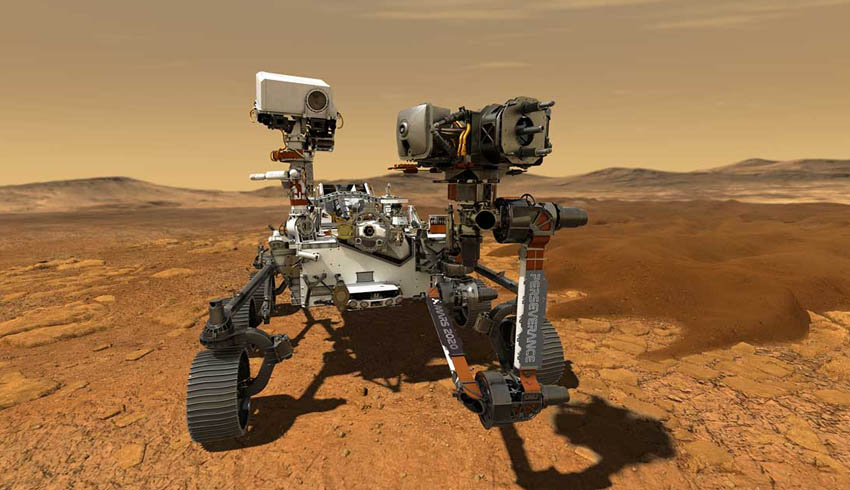With its six wheels, seven-foot-long mechanical arm, and its sensitive detectors, Perseverance is preparing to perform its first science readings to determine whether or not Mars ever hosted ancient life, and will soon begin taking the first scientific samples of soil and rock from the planet.
Currently, Perseverance is exploring the Jezero Crater, which scientists believe was once home to a lake, billions of years ago. While the crater has long dried out, it could be the likely host to evidence of ancient life on the Red Planet.
“If life was there in Jezero Crater, the evidence of that life could be there,” said Abigail Allwood, a key member of the Perseverance “arm science” team.
Before taking its first samples, the rover will use X-Ray and ultraviolet light to inspect tiny segments of rock surfaces, for possible evidence of past microbial activity.
Perseverance’s X-Ray instrument (called Planetary Instrument for X-ray Lithochemistry – or PIXL), which is located at the end of its arm, is also able to determine the composition of Martian dust clinging to the target, according to Allwood, PIXL’s principal investigator at NASA’s Jet Propulsion Laboratory in Southern California.
“We got our best-ever composition analysis of Martian dust before it even looked at rock,” Allwood said, speaking of Perserverance’s surprisingly successful results while PIXL was still being tested.
NASA has now announced that within the next two weeks, Perseverance will collect its first-ever sample of Martian rock from the Jezero Crater, with future missions already planned in order to transport said samples back to Earth.
“When Neil Armstrong took the first sample from the Sea of Tranquility 52 years ago, he began a process that would rewrite what humanity knew about the moon,” said Thomas Zurbuchen, associate administrator for science at NASA Headquarters.
“I have every expectation that Perseverance’s first sample from Jezero Crater, and those that come after, will do the same for Mars. We are on the threshold of a new era of planetary science and discovery.”
While it took Armstrong just three minutes and 35 seconds to collect NASA’s first sample from the moon, Perseverance will need a little longer than that.
The rover will require about 11 days to complete its first sampling, due to the fact that it must await instructions sent from hundreds of millions of miles away, as well as relying on its Sampling and Caching System – which NASA calls “the most complex and capable, as well as the cleanest, mechanism ever sent to space”.
In order to collect a sample, Perseverance will need to get the object within its reach, and then perform an imagery survey, so NASA’s science team back on Earth can determine the exact location for taking the sample, as well as a separate target site in the same area for “proximity science”.
“The idea is to get valuable data on the rock we are about to sample by finding its geologic twin and performing detailed in-situ analysis,” said science campaign co-lead Vivian Sun, from NASA's Jet Propulsion Laboratory in southern California.
“On the geologic double, first we use an abrading bit to scrape off the top layers of rock and dust to expose fresh, unweathered surfaces, blow it clean with our Gas Dust Removal Tool, and then get up close and personal with our turret-mounted proximity science instruments SHERLOC, PIXL, and WATSON.”
PIXL, SHERLOC (Scanning Habitable Environments with Raman & Luminescence for Organics & Chemicals), and the WATSON (Wide Angle Topographic Sensor for Operations and eNgineering) camera will provide mineral and chemical analysis of the abraded target, according to NASA.
Perseverance’s SuperCam and Mastcam-Z instruments will also aid in the process. Together, all five instruments will enable “unprecedented analysis of geological materials at the worksite”, said NASA.
“After our pre-coring science is complete, we will limit rover tasks for a sol, or a Martian day,” said Sun. “This will allow the rover to fully charge its battery for the events of the following day.”
While Perseverance does hope to uncover some clues as to whether or not the Jezero Crater harboured ancient lifeforms, the rover’s sampling process is not necessarily just performed in search of such evidence.
“Not every sample Perseverance is collecting will be done in the quest for ancient life, and we don’t expect this first sample to provide definitive proof one way or the other,” said Perseverance project scientist Ken Farley, of Caltech.
“While the rocks located in this geologic unit are not great time capsules for organics, we believe they have been around since the formation of Jezero Crater and incredibly valuable to fill gaps in our geologic understanding of this region – things we’ll desperately need to know if we find life once existed on Mars.”

Hannah Dowling
Writer – Defence and Aerospace, Momentum Media
Hannah joined Momentum as a journalist in 2019, and has since written breaking news stories across a diverse range of corporate industries, including finance, real estate, investments and aviation. She has a keen interest in the global aviation sector, with a particualy focus on improving overall individual wellbeing across the aerospace industry.
Hannah graduated from Macquarie University in Sydney Australia with a Bachelor of Media (Journalism) and is currently pursuing postgraduate studies.
Send Hannah an email at [email protected] or connect via Twitter or LinkedIn.

